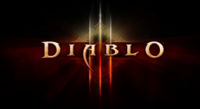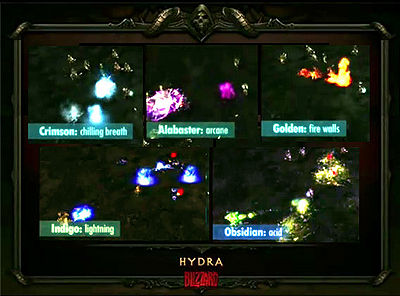Difference between revisions of "Hydra"
(→Runestone Effects) |
|||
| Line 65: | Line 65: | ||
==Runestone Effects== | ==Runestone Effects== | ||
| + | [[File:Runes-hydra-all.jpg|thumb|400px|[[Hydra]] with [[Runestones]].]] | ||
[[Jay Wilson]] provided a whole new insight into the changes made to [[Runestones]] with a short quote from Gamescom, in August 2010. [http://diablo.incgamers.com/blog/comments/jay-wilson-interview-g4tv/] | [[Jay Wilson]] provided a whole new insight into the changes made to [[Runestones]] with a short quote from Gamescom, in August 2010. [http://diablo.incgamers.com/blog/comments/jay-wilson-interview-g4tv/] | ||
Revision as of 11:46, 15 November 2010
- "Project Hydra" was the codename for the Diablo III project and team before the announcement at WWI 2008.
Hydra is a Tier 4 skill unlocked for the Wizard at level 10, summoning a hydra that attacks enemies with bolts of fire.
Contents
Background
| Diablo III Skill [e] | |
|---|---|

| |
| Hydra Active, 5 ranks | |
| Used by: | Wizard |
| Creates a hydra that attacks your enemies with bolts of fire. Hydra deals X-Y damage per attack. | |
| Type: | Direct Damage |
| Quantity: | 6-10 damage |
| Effect: | Turret shooting bolts |
| School: | Fire |
| Mana cost: | 12 |
| Cast time: | Instant |
| Duration: | None |
| Cooldown: | 1.5 sec |
| Synergies: | None |
| Requires: | N/A |
| Prereq of: | N/A |
Among the many secrets of the Ancient Repositories, the Wizard found the Hydra spell to call forth a ward to dispatch of enemies from multiple directions.
Skill Design
This was too high level to use at BlizzCon 2009, though players sorely wanted to try it out and see the improvements from Diablo I. Graphical, if nothing else.
It's interesting to contemplate what the Hydra (multi-strike) rune would do to Hydra. More than 3 heads per cast? Plus, Greek Mythology fans could geek out. Especially if they named their character Learnean.
Skill Rank Table
- Rank 1: Hydra deals 6-10 damage per attack.
Only Rank 1 is currently known.
Synergies
Hydra benefits directly from the following traits:
- Glass Cannon: Increases damage done by spells and increases armor.
- Intimidation: Increases damage done and reduces vendor costs.
- Quickening: Increases spell casting speed.
- Beast Hunter: Damage bonus against beasts.
- Demonsbane: Damage bonus against Demons.
- Just...Stay...Dead!: Damage bonus against undead.
- Power Surge: Increase critical strike damage.
- Penetrating Spells: Reduces the resistances of your target to your spells by 20%.
Depending on rune socketing, Hydra also benefits from the following traits:
- Black Ice: Frozen targets take 25% more damage from all sources.
- Temporal Flux: Enemies that have been hit by your Arcane spells are slowed down by 25% for 3 seconds.
Runestone Effects
Jay Wilson provided a whole new insight into the changes made to Runestones with a short quote from Gamescom, in August 2010. [1]
- Jay Wilson: One of my favorites is on the Wizard. She has a skill called Hydra, which is largely the same as it was in Diablo 2. Fiery (dragon) heads that shoot fireballs. Depending on which rune the Wizard sockets in that skill, the dragon heads change elements, and it’s a major change. Their entire appearance is altered. They can become poison heads, which shoot bolts of poison that leave pools of acid on the ground. There are lightning heads that shoot Chain Lightning. Cold heads that shoot Frost Bolts that slow enemies. Another rune makes for a bigger fire attack, where the head just breaths a cone of flame.
Jay did not list what all five runes did in Hydra, and his explanation left fans confused. Where were the three elemental damage types coming from? Nothing like that seemed to fit with the previous rune functions.
This mystery was cleared up a few days later with new info Bashiok provided to Flux, webmaster of fansite Diii.net. [2]
He explained that the Hydra runes provide:
- Extra damage in the form of firewalls.
- Multistrike (rapid fire)
- And the 3 elemental properties.
Extra damage and multishot are consistent with previously known rune functions. One of the elementals comes from the wildcard rune, and the other comes from what used to be the Energy rune. That rune now functions as a second wildcard in most skills, since changes to the resources made the mana-saving property obsolete. (Plus it just wasn't cool enough, in most instances.)
So Hydra isn't a total outlier; it's just got one rune, (formerly known as Lethality) that usually affects critical bonuses, that's doing something very different (providing an elemental damage change, in Hydra).
Development

The hydra spell was originally seen in Diablo I, then called Guardian. The principle was that three heads were summoned from the ground, shooting firebolts at enemies for a limited time. They are more fun to cast than efficient to kill anything with.
In Diablo II, they were turned into flaming heads, and got the name Hydra. While not dealing damage to anyone near the flames, the firebolts are of more use, especially if concentrating the fire on single targets at a time, and alternating skills while waiting for the cooldown.
The Diablo III Hydra spell was first shown at BlizzCon 2009, but was unfortunately too high level to try out by the fans.
At BlizzCon 2010 it was shown in the gameplay panel but also at the PvP Arena.It has 3 heads and it's surrounded by fire.With a rune it can change into a electric,ice,acid and arcane.
Previous Versions:
Trivia
Hydra was the codename for the Diablo III project and team before the announcement at WWI 2008.
Media
You can find pictures in the Diablo 3 screenshot and picture gallery:
Related Articles
References
